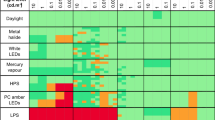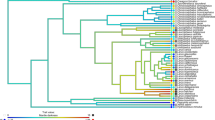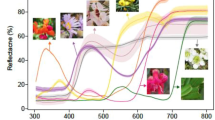This optical feature of some iridescent wings catches a suitor's eye in the deep forest.
Abstract
Iridescent butterfly scales are visually stunning structures that reflect highly saturated colour. They also create an array of non-chromatic optical phenomena, such as polarization, polarization mixing and highly directional flashes1,2, but the ecological purpose of these effects is unclear3,4. Here we show that polarized light is used in mate recognition by Heliconius butterflies, a genus that is known to rely on visual cues in sexual selection and speciation5. This terrestrial example of exploitation of polarized light may have adaptive value in dense forest, where illumination varies greatly in spectrum and intensity.
This is a preview of subscription content, access via your institution
Access options
Subscribe to this journal
Receive 51 print issues and online access
$199.00 per year
only $3.90 per issue
Buy this article
- Purchase on Springer Link
- Instant access to full article PDF
Prices may be subject to local taxes which are calculated during checkout


Similar content being viewed by others
References
Vukusic, P., Sambles, J. R. & Lawrence, C. R. Nature 404, 457 (2000).
Vukusic, P., Sambles, J. R., Lawrence, C. R. & Wootton, R. J. Proc. R. Soc. Lond. B 269, 7–14 (2002).
Kemp, D. J. Trends Ecol. Evol. 17, 298–300 (2002).
Parker, A. Mater. Today 5, 26–31 (2002).
Jiggins, C. D., Naisbit, R. E., Coe, R. L. & Mallet, J. Nature 411, 302–305 (2001).
Shashar, N., Hagan, R., Boal, J. G. & Hanlon, R. T. Vis. Res. 40, 71–75 (2000).
Beltran, M. et al. Mol. Biol. Evol. 19, 2176–2190 (2002).
Estrada, C. & Jiggins, C. D. Ecol. Entomol. 27, 448–456 (2002).
Endler, J. A. Ecol. Monogr. 63, 1–27 (1993).
Shashar, N., Cronin, T. W., Wolff, L. B. & Condon, M. A. Biotropica 30, 275–285 (1998).
Kinoshita, M., Sato, M. & Arikawa, K. Naturwissenschaften 84, 199–201 (1997).
Kelber, A. Nature 402, 251 (1999).
Author information
Authors and Affiliations
Corresponding author
Ethics declarations
Competing interests
The authors declare no competing financial interests.
Rights and permissions
About this article
Cite this article
Sweeney, A., Jiggins, C. & Johnsen, S. Polarized light as a butterfly mating signal. Nature 423, 31–32 (2003). https://doi.org/10.1038/423031a
Issue Date:
DOI: https://doi.org/10.1038/423031a
This article is cited by
-
Hyperreflective photonic crystals created by shearing colloidal dispersions at ultrahigh volume fraction
Microsystems & Nanoengineering (2024)
-
Liquid crystal-templated chiral nanomaterials: from chiral plasmonics to circularly polarized luminescence
Light: Science & Applications (2022)
-
Analysis of the Diffraction Pattern Generated by the Wings of Graphium sarpedon
Brazilian Journal of Physics (2022)
-
Colours as aggregation signals in Lepidoptera: Are Heliconius Müllerian mimics?
Evolutionary Ecology (2022)
-
Sound vs. light: wing-based communication in Carboniferous insects
Communications Biology (2021)
Comments
By submitting a comment you agree to abide by our Terms and Community Guidelines. If you find something abusive or that does not comply with our terms or guidelines please flag it as inappropriate.



